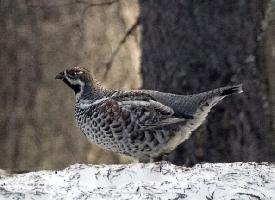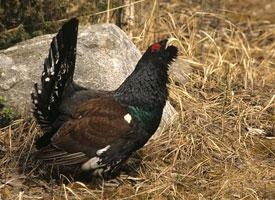
Popis zvířete
The Hazel grouse, scientifically known as Tetrastes bonasia, is a captivating species of bird that belongs to the grouse family. This small to medium-sized bird is a resident species in the temperate forests across Eurasia, from Western Europe through to the Siberian taiga. Its presence is often indicated by its distinctive call rather than being seen, as it is a shy and elusive creature that blends seamlessly into its woodland habitat.Physically, the Hazel grouse is a sight to behold with its subtle yet beautiful plumage. The bird exhibits a remarkable adaptation to its forest environment, featuring a mottled pattern of brown, white, and black feathers that provide excellent camouflage against the forest floor and undergrowth. This coloration varies slightly between males and females, with males typically showcasing a more vivid pattern. Both sexes have a relatively small head and a short, triangular bill that is well-suited to their diet of seeds, berries, and insects. The wings are rounded, enabling quick, powerful flights over short distances, which is a common escape response to threats.
One of the most fascinating aspects of the Hazel grouse is its behavior and lifestyle. These birds are predominantly ground-dwelling, spending the majority of their time foraging for food on the forest floor. Their diet is quite varied and changes with the seasons; it includes a wide range of woodland products from seeds and berries to small invertebrates. During winter, they are known to feed on the buds and twigs of trees, demonstrating their adaptability to the harsh conditions of their habitat.
Breeding season brings out the more social side of these typically solitary birds. The male performs a unique and enchanting mating display that includes a series of sounds and movements designed to attract a female. Once a pair is formed, they work together to build a nest on the ground, hidden among the dense vegetation. The female lays a clutch of eggs, which she incubates, while the male stands guard and forages for both of them.
The chicks are precocial, meaning they are relatively mature and mobile from the moment of hatching. This is crucial for their survival, as it enables them to follow their parents and learn how to forage for food from a very young age. The family unit remains together for some time, with the young birds learning the essential skills for survival from their parents.
Conservation of the Hazel grouse involves protecting the mature, dense forests that are their home. Although currently not considered endangered, their populations are affected by logging, deforestation, and habitat fragmentation. Efforts to preserve their natural habitats are vital for the continued survival of this intriguing species.
In conclusion, the Hazel grouse (Tetrastes bonasia) is a remarkable bird with a unique set of characteristics and behaviors that make it a fascinating subject of study for ornithologists and bird watchers alike. Its ability to blend into its environment, coupled with its intriguing social behaviors during the breeding season, makes it a cherished species among those who are fortunate enough to encounter it in the wild.
Podobná zvířata
Nové fotografie zvířat
Top 10 zvířat
- Dolphin gull (Leucophaeus scoresbii)
- Diana monkey (Cercopithecus diana)
- Moustached guenon (Cercopithecus cephus)
- Galápagos tortoise (Geochelone nigra complex)
- Stone loach (Barbatula barbatula)
- Japanese macaque (Macaca fuscata)
- Greek tortoise (Testudo graeca)
- Russian tortoise (Testudo horsfieldii)
- Common flying dragon (Draco volans)
- Galápagos penguin (Spheniscus mendiculus)


